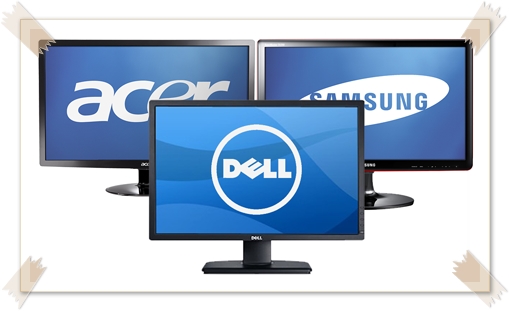 Increasingly sophisticated computer technology embedded in an impact on other supporting tools including computer monitors. Computer
monitors have now switched from tube monitors to LCD computer monitor
that does not take up much space and too comfortable to use. LCD itself stands for Liquid Crystal Display and is also known as flatscreens.
Increasingly sophisticated computer technology embedded in an impact on other supporting tools including computer monitors. Computer
monitors have now switched from tube monitors to LCD computer monitor
that does not take up much space and too comfortable to use. LCD itself stands for Liquid Crystal Display and is also known as flatscreens.
Before becoming a computer LCD monitor, LCD itself has been used first for a while, for example in digital watches and laptop. In recent years they have become standard for desktop monitors. During the same time, the LCD TV market has also been conquered.
Flatscreen monitors are thinner and lighter than the CRT (cathode ray tube). They
also need to use less energy and do not emit electromagnetic radiation,
and is accompanied by technology that is able to produce brighter
images and high resolution and a feast for the eyes.
And the following are important tips to know when you buy a computer LCD monitor. This will help you to understand and be more careful in choosing a LCD monitor.
Here are some tips for choosing a LCD monitor.
1. Screen Size
The screen size is measured in inches, diagonally from the lower left to the upper right corner of the right of the screen. The size of this monitor is available from 15 "to 30". The most common sizes or many users often used today is the size of 19 "to 22", but it is not uncommon to buy a larger size.
The larger size signifies that you have more space on your desktop. You may be able to see the open windows in parallel. However, the monitor has a larger size can take a lot of space for you and tend to be more expensive.
2. Aspect Ratio
Aspect ratio describes the relative amounts of horizontal to vertical pixels in the monitor. Standard CRT monitor has a 4:3 ratio. Today you will find a wide-screen monitor has an aspect ratio as a movie screen, ie 16:9 or 16:10. 16:9 is also often called HD (High Definition).
If you're watching a DVD on a computer, you can avoid the black bars on your screen to the big screen. Width ratio is also the most convenient solution to view multiple windows in parallel. The only reason to use.
4:3 is for some reason or you have limited space on your desktop.
3. Resolution
Resolution is the number of pixels displayed horizontally and vertically. Due to the inherent technology of LCD, flatscreen only have one resolution or resolutions optimized default. Therefore, they describe the native resolution of the absolute number of pixels present vertically and horizontally.
Unlike CRT monitors that use low resolution compared to the flat screen resulting in a blurred image. Therefore,
it is important to select the correct resolution from the beginning
because you can not change it, if you accept it unless the image quality
potluck.
Higher resolution means having a display sharper images, a high degree of clarity and a more desktop space. It will look perfect when you run multitasking and watch movies on your monitor. On the other hand, the text becomes much smaller and harder to read. So the high resolution should be avoided if you have less than perfect eyesight.
4. Contrast Ratio
Contrast ratio describes the difference between black and white is displayed on the LCD monitor. High ratio of white and black should be balanced, as well as a greater degree among the gray. The best ratio you can get is 1.000:1, the contrast ratio is a difficult topic of discussion. You can not really compare values between different manufacturers.
5. BrightnessLCD Monitor to get the light from some backlight. Brightness is measured in candelas per square meter (cd/m2). A minimum of a high rating of 300 cd/m2, which is to use to watch movies or play games on your computer. For office work and browsing you just need a lower brightness level of 200-250 cd/m2.
6. Viewpoint
The higher point of view, then others can see the monitor clearly on the side of the screen. Compared with CRT, LCD has a limited viewing angle. However,
this feature is only interesting if you expect yourself or your friends
look at your monitor from a different perspective. You can ignore it if you have always been right in front of the monitor.
7. Port
In
addition to talking about technology on the monitor, it helps us pay
attention that there is a port on the monitor you want to buy. Most importantly, check the connector to support your video card. Here is a brief overview of the most common port:
- DisplayPort. Latest digital display interfaces produced since 2008.
- HDMI, High Definition Multimedia Interface an audio device / digital video that has been in production in 2003.
- DVI. Digital Video Interface is a digital device, the first video produced to replace the VGA since 1999.
- VGA (Video Graphics Array, an old analog connector, first produced in 1987
That's a few tips on how to choose the right LCD monitor. May be useful for you ...
(^ _ ^)
No comments:
Post a Comment